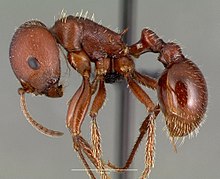Pogonomyrmex
| Pogonomyrmex | |
|---|---|

| |
| Pogonomyrmex barbatus worker | |
| Scientific classification | |
| Domain: | Eukaryota |
| Kingdom: | Animalia |
| Phylum: | Arthropoda |
| Class: | Insecta |
| Order: | Hymenoptera |
| Family: | Formicidae |
| Subfamily: | Myrmicinae |
| Tribe: | Pogonomyrmecini |
| Genus: | Pogonomyrmex Mayr, 1868 |
| Type species | |
| Formica badia Latreille, 1802
| |
| Diversity[1] | |
| 69 species | |
| Synonyms | |
|
Ephebomyrmex Wheeler, 1902 | |
Pogonomyrmex is a genus of harvester ants, occurring primarily in the deserts of North, Central, and South America, with a single endemic species from Haiti.[2]
Description
The genus name originated from the
Venom
Pogonomyrmex (sensu stricto) workers have the most toxic
Nests
These ants dig very deep nests with many underground chambers in which they keep seeds, from which they derive food for their larvae. The areas around most Pogonomyrmex (sensu stricto) nests tend to be utterly devoid of vegetation, and are easily seen from a distance.[citation needed]
Predation
In addition to horned lizards, predatory wasps in the genus Clypeadon feed only on Pogonomyrmex workers, paralyzing them with their venom, and carrying them back to a burrow where they will serve as food for the wasp's larva.[2]
Species
As of 2014, there are 69 extant and 1 fossil species in the genus.[1]
- Pogonomyrmex abdominalis Santschi, 1929
- Pogonomyrmex andinus Kusnezov, 1951
- Pogonomyrmex anergismus Cole, 1954
- Pogonomyrmex angustus Mayr, 1870
- Pogonomyrmex anzensis Cole, 1968
- Pogonomyrmex apache Wheeler, 1902
- Pogonomyrmex atratus Santschi, 1922
- Pogonomyrmex badius (Latreille, 1802)
- Pogonomyrmex barbatus(Smith, 1858)
- Pogonomyrmex bicolor Cole, 1968
- Pogonomyrmex bigbendensis Francke & Merickel, 1982
- Pogonomyrmex bispinosus (Spinola, 1851)
- Pogonomyrmex brevibarbis Emery, 1906
- Pogonomyrmex brevispinosus Cole, 1968
- Pogonomyrmex bruchi Forel, 1913
- Pogonomyrmex californicus (Buckley, 1866)
- Pogonomyrmex carbonarius Mayr, 1868
- Pogonomyrmex catanlilensis Gallardo, 1931
- Pogonomyrmex coarctatus Mayr, 1868
- Pogonomyrmex colei Snelling, 1982
- Pogonomyrmex comanche Wheeler, 1902
- Pogonomyrmex cunicularius Mayr, 1887
- Pogonomyrmex desertorum Wheeler, 1902
- †Pogonomyrmex fossilis Carpenter, 1930
- Pogonomyrmex guatemaltecus Wheeler, 1914
- Pogonomyrmex hoelldobleri Johnson, Overson & Moreau, 2013[4]
- Pogonomyrmex huachucanus Wheeler, 1914
- Pogonomyrmex humerotumidus Vásquez-Bolaños & Mackay, 2004
- Pogonomyrmex imberbiculus Wheeler, 1902
- Pogonomyrmex inermis Forel, 1914
- Pogonomyrmex kusnezovi Cuezzo & Claver, 2009[5]
- Pogonomyrmex laevigatus Santschi, 1921
- Pogonomyrmex laevinodis Snelling, 1982
- Pogonomyrmex laticeps Santschi, 1922
- Pogonomyrmex lobatus Santschi, 1921
- Pogonomyrmex longibarbis Gallardo, 1931
- Pogonomyrmex magnacanthus Cole, 1968
- Pogonomyrmex marcusi Kusnezov, 1951
- Pogonomyrmex maricopa Wheeler, 1914
- Pogonomyrmex mayri Forel, 1899
- Pogonomyrmex mendozanus Cuezzo & Claver, 2009[5]
- Pogonomyrmex meridionalis Kusnezov, 1951
- Pogonomyrmex micans Forel, 1914
- Pogonomyrmex mohavensis Johnson & Overson, 2009[6]
- Pogonomyrmex montanus MacKay, 1980
- Pogonomyrmex naegelii Emery, 1878
- Pogonomyrmex occidentalis (Cresson, 1865)
- Pogonomyrmex odoratus Kusnezov, 1949
- Pogonomyrmex pima Wheeler, 1909
- Pogonomyrmex pronotalis Santschi, 1922
- Pogonomyrmex rastratus Mayr, 1868
- Pogonomyrmex rugosus Emery, 1895
- Pogonomyrmex salinus Olsen, 1934
- Pogonomyrmex saucius Wheeler & Mann, 1914
- Pogonomyrmex schmitti Forel, 1901
- Pogonomyrmex snellingi Taber, 1998
- Pogonomyrmex stefani Lattke, 2006[7]
- Pogonomyrmex striatinodus Fernández & Palacio, 1998
- Pogonomyrmex subdentatus Mayr, 1870
- Pogonomyrmex subnitidus Emery, 1895
- Pogonomyrmex sylvestris Lattke, 1991
- Pogonomyrmex tenuipubens Santschi, 1936
- Pogonomyrmex tenuispinus Forel, 1914
- Pogonomyrmex texanus Francke & Merickel, 1982
- Pogonomyrmex theresiae Forel, 1899
- Pogonomyrmex uruguayensis Mayr, 1887
- Pogonomyrmex variabilis Santschi, 1916
- Pogonomyrmex vermiculatus Emery, 1906
- Pogonomyrmex wheeleri Olsen, 1934
Gallery
-
P. californicus
-
P. barbatus with psammophore visible
-
Pogonomyrmex collecting food item
-
Larvae of P. barbatus
References
- ^ a b Bolton, B. (2014). "Pogonomyrmex". AntCat. Retrieved 23 July 2014.
- ^ a b Cole, A.C. 1968. Pogonomyrmex Harvester Ants: a study of the genus in North America. University of Tennessee Press, Knoxville, TN.
- ^ W. L. Meyer (1996-05-01). "Chapter 23 — Most Toxic Insect Venom". Book of Insect Records. University of Florida. Archived from the original on 2008-06-13.
- ^ Johnson, R. A., et al. (2013). A new species of seed-harvester ant, Pogonomyrmex hoelldobleri (Hymenoptera: Formicidae), from the Mohave and Sonoran Deserts of North America.[permanent dead link] Zootaxa 3646(3), 201-27.
- ^ a b Cuezzo, F. and S. Claver. (2009). Two new species of the ant genus Pogonomyrmex (Hymenoptera: Formicidae) from Argentina. Rev. Soc. Entomol. Argent 68(1-2), 97-106.
- ^ Johnson, R. A. and R. P. Overson. (2009). A new North american species of Pogonomyrmex (Hymenoptera: Formicidae) from the Mohave Desert of eastern California and western Nevada. Journal of Hymenptera Research 18(2), 305-14.
- ^ Lattke, J. E. (2006). A new species of Pogonomyrmex (Hymenoptera: Formicidae) from gallery forests of the Orinoco Watershed, Venezuela.[permanent dead link] Myrmecologische Nachrichten 8, 53-57.
External links
 Media related to Pogonomyrmex at Wikimedia Commons
Media related to Pogonomyrmex at Wikimedia Commons




